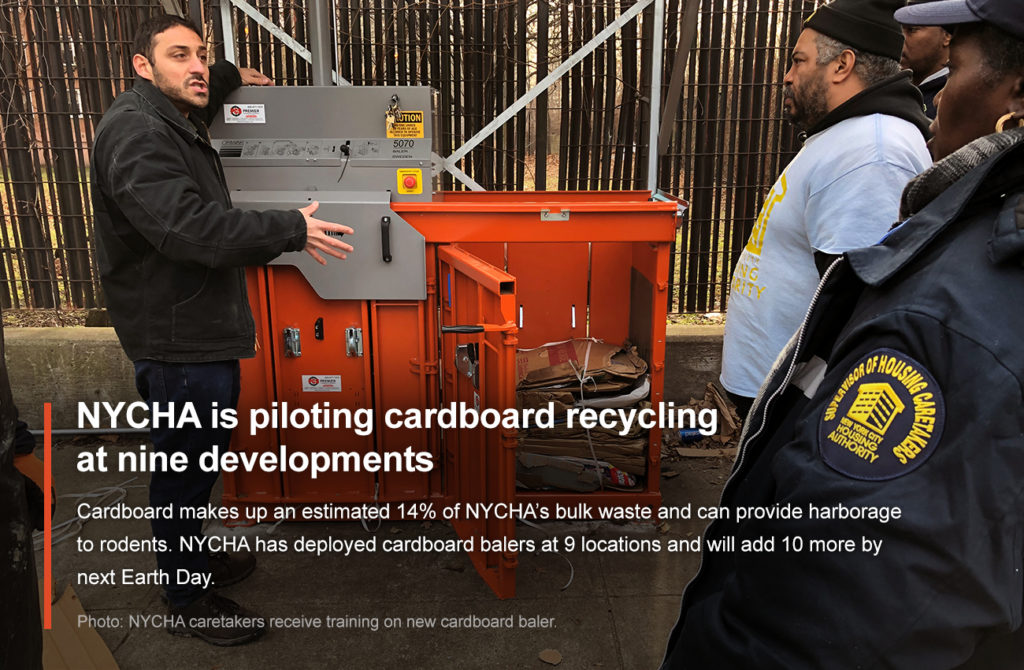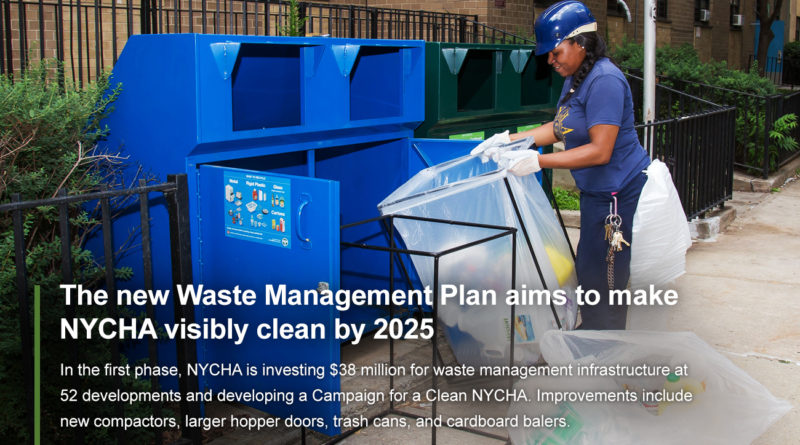The Authority’s New Plan to Tackle Waste
Every year, NYCHA developments produce nearly 200,000 tons of waste. Managing such a large amount of waste and the pests it attracts is a daily challenge. This month, the Authority released its NYCHA 2.0 Waste Management Plan to tackle this challenge and improve resident quality of life by making NYCHA developments visibly clean and free of pests by 2025.
The plan is the result of conversations with partners, including more than 4,500 residents from 219 developments, and is guided by the following vision for a clean NYCHA:
- NYCHA campuses should be free of visible garbage, litter, and pests;
- Residents should have convenient and clearly marked locations to deposit garbage of all types, including recyclables and food waste; and
- Waste management infrastructure should be well maintained, adequate for the volume of waste, and state-of-the-art wherever possible.
“Our priority is ensuring that the 390,000 New Yorkers who rely on us have the best quality of life, and our new waste management plan is critical to that mission,” said General Manager Vito Mustaciuolo. “We thank Mayor de Blasio for his ongoing commitment to our residents as we work every day to provide them the safe, clean homes they deserve.”
The initial $38 million for the plan is made possible in part by Mayor Bill de Blasio’s commitment to the Neighborhood Rat Reduction Plan, which includes the replacement of 223 interior and 36 exterior waste compactors by 2021.
The plan focuses on making proper waste disposal more convenient, expanding and improving recycling, eliminating food sources for rodents and pests, and working with residents and community partners on waste-related issues. It includes 12 initiatives that will boost ongoing daily work by caretaker staff; many of the initiatives have already begun.
Since NYCHA buildings were first constructed, waste generated by American households has tripled, while NYCHA’s waste infrastructure has not been modernized. In addition to improved policies and procedures, as well as partnerships with organizations such as GrowNYC on recycling education for residents, NYCHA is investing in enhancements, including:
- Enlarged trash hopper doors for improved waste disposal at 81 developments by May 2020,
- New cardboard bailers to support recycling at 19 developments citywide by April 2020,
- Mattress recycling bins at 15 developments by April 2020,
- New trash receptacles installed next to entryways and on high-traffic paths at 17 developments this spring,
- Bulk crushers – which break down large items and compact them in a closed container – at every development that can accommodate them by 2025, and
- Collecting food scraps through the Department of Sanitation’s curbside organics program at small NYCHA buildings that receive curbside garbage collection starting this year.
To read all of the initiatives, access the full plan here.
The NYCHA 2.0 Waste Management Plan is part of NYCHA’s ongoing Sustainability Agenda, which was released on Earth Day 2016 to provide better service for residents, reduce energy and costs, and curb the effects of climate change. The plan is also aligned with the City’s Zero Waste by 2030 goal outlined in OneNYC, the de Blasio administration’s blueprint for tackling New York City’s most significant challenges.








